Locomotives of New Zealand
Locomotives of New Zealand currently in operation owned by KiwiRail consist of 172 diesel-electric locomotives, 22 electric locomotives, 3 railcars, and 103 shunting locomotives. There are also 19 diesel multiple units in Auckland, owned by Auckland Transport, 71 electric multiple units owned by the Greater Wellington Regional Council, 57 electric multiple units owned by Auckland Transport, and diesel-electric and steam locomotives and railcars in working order owned by private companies or preservation societies.
All New Zealand's main-line locomotives are 1067 mm (3 foot 6 inch) gauge.
Classification details
The locomotives of KiwiRail and its predecessors are divided into classes. Each class was designed to perform specific duties. A class can be as small as one individual locomotive, and the largest class to run on New Zealand rails was the DA class, which comprised 146 locomotives.
20 new DL class Chinese-built diesel electric locomotives arrived in mid-2012.
Steam locomotives (which were retired from regular service by the end of October 1971) were originally categorised with just a single letter, such as the "F class". When a new class was built as an enhancement of an old class, the old class's letter was re-used, followed by a superscript upper-case letter. For example, the 1906 A class was followed by the AA and AB classes.
Diesel-electric and electric locomotive classifications originally consisted of an upper-case D or E respectively followed by a second and sometimes a third (sub-class) letter. The second and third letters are sometimes represented as smaller-sized upper case (for example, as seen on many locomotive cab-side number plates).
Diesel and diesel-electric classes appear to have originally been classified, after the first class letter ('D' as alluded to above), by the second letter being allocated to indicate the country of manufacture (for example DA for the American EMD designs, which were also, later, built in Canada and Australia; DE for England or 'English Electric'; DJ for the Mitsubishi units from Japan). Whilst this was a reasonable starting point, such issues as the introduction of 'sister models' and sub-classing caused by rebuild and refurbishment resulted in the pragmatic, contiguous use of other class letters. For example, the eight-cylinder version of the DA class became the DB class, and was later rebuilt as the DBR. When the DA class rebuilding began, the rebuilt locomotives became the DC class. Following the DJ there was a large gap in the classification continuum as NZR took a different tack and catalogued their new GE power as the DX class and then (because the original DFs had since been withdrawn) new Canadian-built EMD units took over the DF classification.
There are exceptions, and new classes were not always given the classification that alphabetically followed that of the previous class that had most recently been acquired. If an entire class had been withdrawn from service and the classification no longer in use, it was sometimes re-used; for example, two A classes exist, one from 1873 and one from 1906.
Traffic Monitoring System
Following the introduction of the computer-based Traffic Monitoring System (TMS) and consequent renumbering, classes were identified by the two upper-case letters with the first letter remaining D or E respectively and sub-classes being indicated by a third upper-case letter, such as DAA (DA modified for hump shunting), DAR (DA with rebuilt superstructure), DFT (DF with turbo-conversion), DXR (rebuilt DX), DQ (EMD units imported from Queensland), QR (EMD units imported from Queensland and placed into service unrebuilt - this non-standard classification originally intended to be temporary as these units were intended to eventually undergo rebuild). Most diesel-electric shunting locomotives have a three-letter classification with DS as the first two letters, following on from the original diesel-electric shunting class that was known simply as the DS class.
For electric locomotives the second letter often referred to where the locomotive was based, such as EC in Christchurch, EO in Otira and EW in Wellington. The ED and EF classes were an exception. The EM class in Wellington possibly stands for Electric Motor. ET is Electric Trailer. The DM class units were an exception to this.
Almost all railcars were classified RM (Rail Motor), and individual classes were known by alternate names such as the Vulcan railcars of the South Island and the Wairarapa railcars that ran over the Rimutaka Incline to the Wairarapa.
Liveries
New Zealand's locomotives have appeared in several different liveries over the ages. Steam locomotives were mainly black. When the railcars and first-generation diesels came in, they were painted in "carnation red" with a white or yellow stripe.
In the 1970s the first different livery appeared. Eleven members of the DJ class were painted "Southerner Blue" (mainly dark blue) to haul the Southerner express in the South Island. The Silver Fern railcars appeared in stainless steel, and the DX class, appearing in 1972, were painted "clockwork orange" (orange and yellow). In 1978, the rebuilt DC class appeared in "fruit salad" (red, yellow, grey and black), and many locomotives followed suit. Following the split of New Zealand Rail Limited from the New Zealand Railways Corporation in 1991, a modified livery of blue, yellow, grey and black appeared. For the first time, locomotives wore the name of their operator - New Zealand Rail - in prominent view. This livery was continued after 1993 when New Zealand Rail Limited was privatised, and was slightly modified when the company was renamed Tranz Rail in 1995 by replacing the New Zealand Rail logo with the new Tranz Rail logo and using a different tone of blue, known after Wellington-based creators, Cato Partners, who also designed brands for the divisions of Tranz Rail.[1]
In 2001 a new livery to promote level crossing safety was trialed on DC 4323. This colour scheme was nicknamed "bumble bee" because of its black and yellow colours. Following the takeover of Tranz Rail by Australia's Toll Holdings in 2004, Toll Rail's livery appeared, nicknamed "corn cob", consisting of green and yellow. That same year, DC class (and now DFT/DFB class) locomotives being used on Auckland commuter services began wearing the MAXX livery, which was dark blue and yellow with a MAXX logo on the side. When the New Zealand Government bought Toll NZ's rail and sea operations in 2008, it rebranded them as KiwiRail and introduced its own livery, consisting of grey and red (a second version later followed). Most of today's locomotives are painted in "fruit salad", blue, "bumble bee", "corn cob" or KiwiRail.
List of locomotive classes
This is a list of all classes of locomotives that operate or have operated on New Zealand's national railway network. It does not include locomotives used on private industrial lines or bush tramways. It is believed to be complete, and is sorted in alphabetical order rather than within type. Articles on specific individual classes can be accessed from this page.
Diesel-electric locomotives
(This list includes shunting classes. Some shunting classes worked on revenue services as well as performing yard shunting duties, most notably the DE class when it hauled Queen Elizabeth II's royal train in the early 1950s.)
| Image | Class | Numbers | Number in class | Year(s) introduced | Year(s) withdrawn | Power output | Notes | ||
|---|---|---|---|---|---|---|---|---|---|
| TMS (1980) | pre-1980 | TMS (1980) | pre-1980 | ||||||
 |
DA | DA | 86 - 996 | 1400 - 1545 | 146 | 1955 - 1967 | 1974 - 1989 | 1,060 kW (1,420 hp) | 85 rebuilt as DC class, 5 as DAA, 1 as DAR |
| DAA | DAA | 11 - 63 | 1400 - 1404, 1406 | 5 | 1971 | 1989 | 1,060 kW (1,420 hp) | DA class refitted for low speed running | |
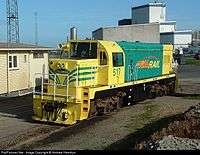 |
DAR | 517 | 1 | 1989 | 2009 | 1,060 kW (1,420 hp) | Modified DA designed for heavy duty shunting | ||
| DB | DB | 1001 - 1180 | 1000 - 1016 | 17 | 1965 - 1966 | 1980 - 1989 | 705 kW (945 hp) | 10 rebuilt as DBR | |
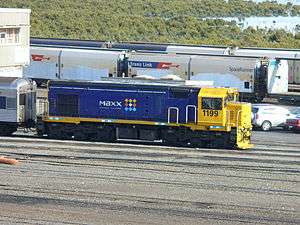 |
DBR | 1199 - 1295 | 10 | 1980 - 1982 | 2002–present | 705 kW (945 hp) | Rebuilt DB | ||
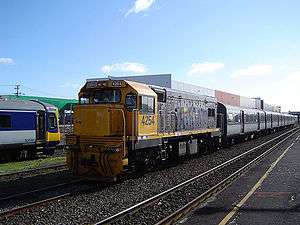 |
DC | DC | 4006 - 4951 | 1551 - 1599 | 85 | 1978 - 1983 | 1992–present | 1,100 kW (1,500 hp) 1,230 kW (1,650 hp) | Rebuilt DA, two types, one with 12-645C engines, and one with 12-645E engines. |
 |
DCP | 4277 - 4945 | 14 | still in use | 1,230 kW (1,650 hp) | DC designated for passenger services | |||
| |
DE | DE | 1308 - 1458 | 501 - 515 | 15 | 1952 | 1984 - 1989 | 490 kW (660 hp) | |
 |
DF (1954) | 1500 - 1510 (1954) 1300 - 1309 (1960) |
10 | 1954 | 1972 - 1975 | 1,120 kW (1,500 hp) | New Zealand's first mainline diesel locomotive | ||
 |
DF | DF (1979) | 6006 - 6317 | 1651 - 1670 | 30 | 1979 - 1981 | 1992 - 1997 | 1,230 kW (1,650 hp) | All rebuilt as DFT |
| DFB | 7010 - 7348 | 10 | 2006 | still in use | 1,800 kW (2,400 hp) | Upgraded DFT | |||
| DFM | 7036 - 7226 | 3 | All reclassified as DFT internally | 1,800 kW (2,400 hp) | Upgraded DFT | ||||
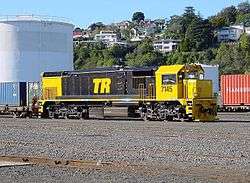 |
DFT | 7008 - 7348 | 30 | 1992 - 1997 | 2013–present | 1,800 kW (2,400 hp) | Rebuilt DF | ||
| DG | DG | 2007 - 2468 | 750 - 791 | 42 | 1955 - 1956 | 1983 | 560 kW (750 hp) | 11 were rebuilt from 1956 DH class | |
| DH (1956) | 766, 772, 777 - 783 | 11 | 1956 | 1968 | 560 kW (750 hp) | Variant of DG class; all rebuilt as DG | |||
| DH | DH | 2816 - 2868 | 900 - 905 | 6 | 1978 | still in use | 672 kW (901 hp) | ||
| DI | DI | 1808 - 1843 | 1100 - 1104 | 5 | 1966 | 1988 - 1989 | 755 kW (1,012 hp) | ||
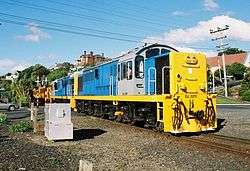 |
DJ | DJ | 3009 - 3689 | 1200 - 1263 | 64 | 1968 - 1969 | 1986 - 1991 | 672 kW (901 hp) | |
 |
DL | 9008 - 9515 | 48 | 2010–2015 | 2,700 kW (3,600 hp) | ||||
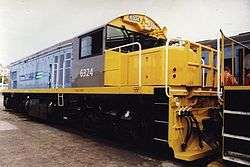 |
DQ | 6007 -6036, 6324 - 6416 | 15 | 1996 - 1998 | 1998 - 2013 | 1,120 kW (1,500 hp) | Rebuilt QR; originally from Queensland. | ||
| |
DSC | DSC | 2000 - 2759 | 400 - 469 | 70 | 1959 - 1967 | 1989–present | 315 kW (422 hp) | |
 |
DSG | 3005 - 3304 | 24 | 1981 - 1983 | still in use | 700 kW (940 hp) | |||
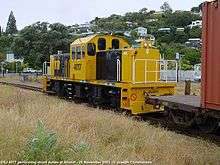 |
DSJ | 4004 - 4060 | 5 | 1984 - 1985 | still in use | 350 kW (470 hp) | |||
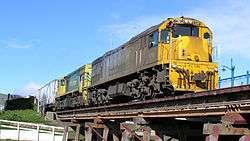 |
DX | DX | 5016 - 5520 | 2600 - 2648 | 49 | 1972 - 1975 | All Rebuilt as DXC & DXB | 2,050 kW (2,750 hp) | 2 rebuilt as DXR |
 |
DXB | 5016 - 5166 & 5448 | 12 | still in use | 2,050 kW (2,750 hp) | Upgraded DX | |||
| |
DXC | 5172 - 5520 5039 | 28 | still in use | 2,050 kW (2,750 hp) | DX class upgraded especially for Midland Line coal trains (C = coal) | |||
| DXH | 0 | All rebuilt as DXB and DXC | 2,050 and 2,400 kW (2,750 and 3,220 hp) | Upgraded DX | |||||
| DXR | 8007, 8022 | 2 | 1993, 2006 | still in use | 2,420 kW (3,250 hp) | Rebuilt DX | |||
| EB | EB | 1809 - 1821 | 25 - 29 | 5 | 1925, 1929 | 1976 - 1980 | 23 kW (31 hp) | Originally battery-electric | |
| QR | 2027 - 2102, 3032 | 25 | 1997 | 1999 | 1,120 kW (1,500 hp) | Originally from Queensland; 15 rebuilt as DQ | |||
Diesel-mechanical and diesel-hydraulic locomotives
Electric locomotives
| Image | Class | Numbers | Number in class | Year(s) introduced | Year(s) withdrawn | Voltage | Power output | Notes | ||
|---|---|---|---|---|---|---|---|---|---|---|
| TMS (1980) | pre-1980 | TMS (1980) | pre-1980 | |||||||
 |
EO | EA | 39 - 74 | 1 - 5 | 5 | 1968, 2008 | 1997, 2011 | 1500V DC overhead | 960 kW (1,290 hp) | Originally EA, reclassified EO in 1980. 3 returned to service in 2008 for Wellington suburban service. Withdrawn again in late 2011. 4 scrapped in 2013, 1 preserved. |
| |
EC | 7 - 12 | 6 | 1928 - 1929 | 1970 | 1500V DC overhead | 885 kW (1,187 hp) | |||
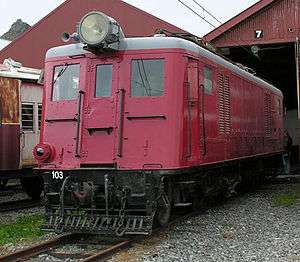 |
ED | ED | 15, 21 | 101 - 110 | 10 | 1938 | 1969 - 1981 | 1500V DC overhead | 670 kW (900 hp) | |
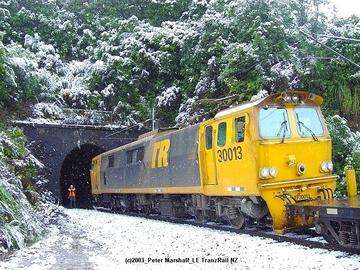 |
EF | 30007 - 30249 | 22 | 1986 - 1988 | 1991–present | 25kV 50Hz AC overhead | 3,000 kW (4,000 hp) | Originally Class 30, reclassified EF | ||
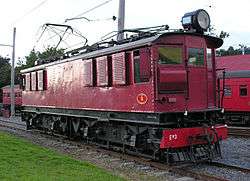 |
EO | 2 - 6 | 5 | 1923 | 1968 | 1500V DC overhead | 510 kW (680 hp) | |||
 |
EW | EW | 107 - 171 | 1800 - 1806 | 7 | 1952 | 1988 | 1500V DC overhead | 1,340 kW (1,800 hp) | |
Battery electric locomotives
Electric multiple units
All Wellington electric multiple units operate on 1500V DC overhead. Auckland's electric multiple units run on 25kV AC overhead.
| Image | Class | Number in class | Location | In service | Formation | Passenger capacity | Notes |
|---|---|---|---|---|---|---|---|
| |
DM/D | 49 | Wellington | 1938 - 2012 | D - DM (two-car) D - DM - D (three-car) |
132 (two-car) 204 (three-car) |
6 sets preserved in museum or private use. |
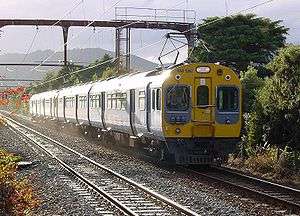 |
EM/ET | 44 | Wellington | 1982 - 2016 | EM - ET | 148 | One set preserved at Canterbury Railway Society. |
| |
FP/FT | 74 | Wellington | 2010 - present | FP - FT | 147 | Named Matangi, after the Māori word for "wind". |
 |
AM | 57 | Auckland | 2014 - present | AMP - AMT - AMA | 230 |
Railcars
All railcars, unless otherwise stated, are designated RM class. For purposes here, they are classified under their common names.
| Image | Class | Number in class | In service | Power type | Passenger capacity | Notes |
|---|---|---|---|---|---|---|
 |
88-seater | 35 | 1955 - 1978 | Diesel-mechanical | 88 | Also known as Fiat or twinset; 14 were converted to AC class articulated carriages |
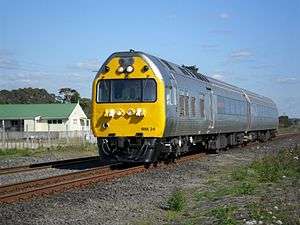 |
Silver Fern | 3 | 1972–present | Diesel-electric | 96 | Used for excursions |
| |
Standard | 6 | 1938 - 1972 | Diesel-mechanical | 48 - 52 | |
 |
Vulcan | 9 | 1940 - 1978 | Diesel-mechanical | 48 - 50 | |
| |
Wairarapa | 7 | 1936 - 1956 | Diesel-mechanical | 25 - 49 |
Experimental railcars included the following:
- Clayton steam railcar
- Edison battery-electric railcar
- Leyland diesel railbus
- Leyland experimental petrol railcar
- MacEwan-Pratt petrol railcar
- Model T Ford railcar
- Sentinel-Cammell steam railcar
Diesel multiple units
| Image | Class | Number in class | In service | Formation | Passenger capacity | Notes |
|---|---|---|---|---|---|---|
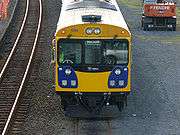 |
ADK/ADB | 9 | 1993 - 2014 | ADK - ADB | 134 | Ex Transperth |
 |
ADL/ADC | 10 | 1993–present | ADL - ADC | 128 | Ex Transperth |
Steam locomotives
| Image | Class | Numbers | Number in class | Year(s) introduced | Year(s) withdrawn | Whyte notation | Notes |
|---|---|---|---|---|---|---|---|
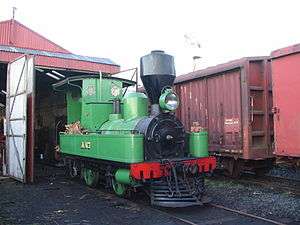 |
A of 1873 | 14 | 1873 | 1905 | 0-4-0T | ||
| A of 1906 | 58 | 1906 | 1969 | 4-6-2 | Includes 30 locomotives reclassified from AD | ||
| AA | 10 | 1914 | 1957 | 4-6-2 | |||
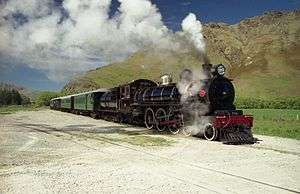 |
AB | 141 | 1915 | 1969 | 4-6-2 | New Zealand's most prolific class of steam locomotive; 10 rebuilt from WAB class | |
| AD | 30 | 1910 | 1916 | 4-6-2 | Reclassified A in 1916 | ||
| B of 1874 | 2 | 1874 | 1890 | 0-4-4-0T Double Fairlie |
|||
| B of 1899 | 10 | 1899 | 1967 | 4-8-0 | Three rebuilt as WE class | ||
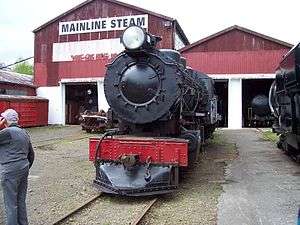 |
BA | 10 | 1911 | 1969 | 4-8-0 | ||
| BB | 30 | 1915 | 1968 | 4-8-0 | |||
| BC | 1 | 1902 | 1927 | 2-8-2 | Originally from Wellington & Manawatu Railway (nationalised 1908) | ||
 |
C of 1873 | 16 | 1873 | 1920 | 0-4-0ST original 0-4-2ST rebuild |
||
| C of 1930 | 24 | 1930 | 1968 | 2-6-2 | |||
 |
D of 1874 | 35 | 1874 | 1927 | 2-4-0T | ||
_Josephine_Otago_Settlers_Museum.jpg) |
E of 1872 | 8 | 1872 | 1906 | 0-4-4-0T Double Fairlie |
||
| E of 1906 | 1 | 1906 | 1917 | 2-6-6-2T Mallet |
|||
| F | 88 | 1872 | 1964 | 0-6-0T | |||
| FA | 13 | 1892 | 1943 | 0-6-2T | |||
| FB | 13 | 1897 | 1943 | 0-6-2T | |||
| G of 1874 | 4 | 1874 | 1918 | 4-4-0ST | |||
| |
G of 1928 | 3 | 1928 | 1937 | 4-6-2+2-6-4 Garratt |
All rebuilt as G of 1937 | |
| G of 1937 | 6 | 1937 | 1956 | 4-6-2 | Rebuilt from G of 1928 | ||
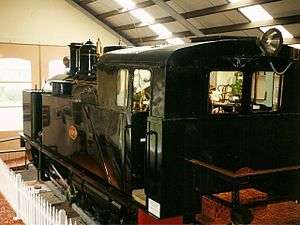 |
H | 199 - 204 | 6 | 1878 | 1955 | 0-4-2T Fell |
Includes H 199, the only remaining Fell locomotive in the world |
| J of 1874 | 32 | 1874 | 1935 | 2-6-0 | |||
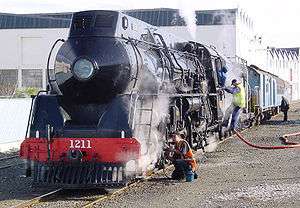 |
J of 1939 | 1200 - 1239 | 40 | 1939 | 1971 | 4-8-2 | 12 were rebuilt as JB class |
 |
JA | 1240 - 1290 | 51 | 1946 - 1956 | 1964 - 1971 | 4-8-2 | Includes JA 1274 - the last NZR steam locomotive built. |
| JB | 12 | 4-8-2 | Oil-burning variant of 1939 J class. 12 locomotives rebuilt from J class. | ||||
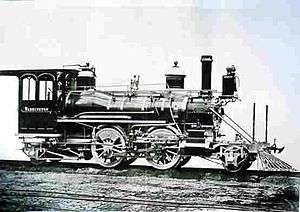 |
K of 1877 | 8 | 1877 | 1927 | 2-4-2 | ||
 |
K of 1932 | 900 - 929 | 30 | 1932 | 1967 | 4-8-4 | |
| KA | 930 - 964 | 35 | 1939 - 1950 | 1964 - 1967 | 4-8-4 | Modified version of K with roller bearings and ACFI feedwater heaters | |
| KB | 965 - 970 | 6 | 1939 | 1968 | 4-8-4 | KA class fitted with trailing-wheel boosters | |
 |
L | 10 | 1877 | 1901 - 1939 | 2-4-0T 4-4-0T 4-4-2T |
||
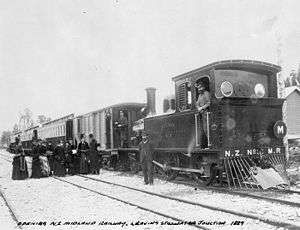 |
LA | 5 | 1887 - 1892 | 1920 - 1928 | 4-4-0T | Originally from New Zealand Midland Railway (nationalised 1900) | |
| M | 4 | 1875 | 1919 - 1928 | 0-6-0T 2-4-4T | |||
| |
N | 12 | 1885 | 1934 | 2-6-2 | Two originally from Wellington & Manawatu Railway (nationalised 1908) | |
| NA | 2 | 1894 | 1929 | 2-6-2 | Originally from Wellington & Manawatu Railway (nationalised 1908) | ||
| NC | 2 | 1902 | 1931 | 2-6-2 | Originally from Wellington & Manawatu Railway (nationalised 1908) | ||
| O | 6 | 1885 | 1922 | 2-8-0 | |||
| OA | 1 | 1894 | 1929 | 2-8-0 | Originally from Wellington & Manawatu Railway (nationalised 1908) | ||
| OB | 2 | 1888 | 1931 | 2-8-0 | Originally from Wellington & Manawatu Railway (nationalised 1908) | ||
| OC | 1 | 1896 | 1930 | 2-8-0 | Originally from Wellington & Manawatu Railway (nationalised 1908) | ||
| P of 1876 | 2 | 1876 | 1885 | 0-6-0ST | |||
| P of 1885 | 10 | 1885 | 1930 | 2-8-0 | |||
| Q of 1878 | 2 | 1878 | 1898 | 2-4-4T | |||
| Q of 1901 | 13 | 1901 | 1957 | 4-6-2 | The world's first 4-6-2 Pacific locomotive | ||
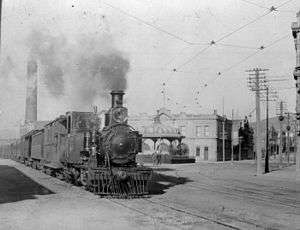 |
R | 18 | 1878 | 1936 | 0-6-4T Single Fairlie |
||
| S | 7 | 1880 | 1927 | 0-6-4T Single Fairlie |
|||
| T | 6 | 1879 | 1928 | 2-8-0 | |||
| U | 9 | 1894 | 1959 | 4-6-0 | |||
| UA | 6 | 1899 | 1937 | 4-6-0 | |||
| UB | 22 | 1901 | 1957 | 4-6-0 | |||
| UC | 10 | 1901 | 1959 | 4-6-0 | |||
| UD | 2 | 1904 | 1931 | 4-6-0 | Originally from Wellington & Manawatu Railway (nationalised 1908) | ||
| V | 13 | 1885 | 1937 | 2-6-2 | Three originally from Wellington & Manawatu Railway (nationalised 1908) | ||
| W | 192, 238 | 2 | 1889 | 1959 | 2-6-2T | Includes W 192, the first NZR locomotive built in New Zealand. | |
| WA | 11 | 1892 | 1962 | 2-6-2T | |||
 |
WAB | 30 | 1918 - 1927 | 1947 - 1969 | 4-6-4T | 14 rebuilt from WS class; 10 rebuilt as AB class | |
| WB | 12 | 1898 | 1957 | 2-6-2T | |||
| WD | 18 | 1901 | 1936 | 2-6-4T | |||
| WE | 3 | 1902 | 1969 | 4-6-4T | Rebuilt from B of 1899; equipped with Fell centre rail braking for use on Rimutaka and Rewanui Inclines. | ||
| WF | 41 | 1904 | 1969 | 2-6-4T | |||
| WG | 20 | 1910 | 1964 | 4-6-4T | 14 rebuilt as WW class | ||
| WH | 3 | 1884 | 1927 | 2-4-2T | Originally from Wellington & Manawatu Railway (nationalised 1908) | ||
| WJ | 1 | 1904 | 1928 | 2-8-4T | Originally from Wellington & Manawatu Railway (nationalised 1908) | ||
| WS | 14 | 1917 | 1936 | 4-6-4T | All rebuilt as WAB class | ||
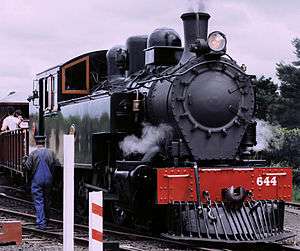 |
WW | 51 | 1913 | 1969 | 4-6-4T | 14 rebuilt from WG class | |
| X | 18 | 1909 | 1957 | 4-8-2 | The world's first 4-8-2 Mountain locomotive | ||
| Y | 3 | 1923 | 1958 | 0-6-0T |
Steam locomotive notes:
- ^ Two other types of locomotives built in the 1870s were included in the A class. All three had a wheel arrangement of 0-4-0T, but were technically and aesthetically quite different. The other A types are often known as the Shanks A and the Mills A, after their respective builders.
- ^ A completely different type of locomotive was nominally classified as being the solitary member of the S class in 1877 (the main S class was not introduced until 1880), but it was typically known as Robina.
References
- ↑ "Cato Partners - Tranz Rail". Retrieved 28 December 2011.
- Heath, Eric, and Stott, Bob; Classic Railcars, Electric and Diesel Locomotives Of New Zealand, Grantham House, 1993
- Heath, Eric, and Stott, Bob; Classic Steam Locomotives Of New Zealand, Grantham House, 1993
External links
- New Zealand Railways Steam Locomotives
- New Zealand Diesel and Electric Traction
- New Zealand Locomotives
- Current New Zealand Locomotive Assignments